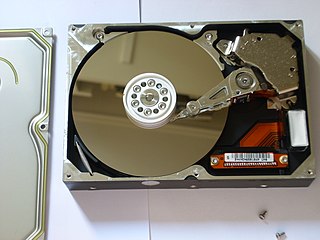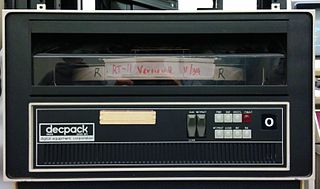Related Research Articles

A hard disk drive (HDD), hard disk, hard drive, or fixed disk, is an electro-mechanical data storage device that stores and retrieves digital data using magnetic storage with one or more rigid rapidly rotating platters coated with magnetic material. The platters are paired with magnetic heads, usually arranged on a moving actuator arm, which read and write data to the platter surfaces. Data is accessed in a random-access manner, meaning that individual blocks of data can be stored and retrieved in any order. HDDs are a type of non-volatile storage, retaining stored data when powered off. Modern HDDs are typically in the form of a small rectangular box.

Magnetic tape is a medium for magnetic storage made of a thin, magnetizable coating on a long, narrow strip of plastic film. It was developed in Germany in 1928, based on the earlier magnetic wire recording from Denmark. Devices that use magnetic tape could with relative ease record and playback audio, visual, and binary computer data.

In computing and optical disc recording technologies, an optical disc (OD) is a flat, usually circular disc that encodes binary data (bits) in the form of pits and lands on a special material, often aluminum, on one of its flat surfaces. Its main uses are physical offline data distribution and long-term archival. Changes from pit to land or from land to pit correspond to a binary value of 1; while no change, regardless of whether in a land or a pit area, corresponds to a binary value of 0.

A hard disk drive platter or hard disk is the circular magnetic disk on which digital data is stored in a hard disk drive. The rigid nature of the platters is what gives them their name. Hard drives typically have several platters which are mounted on the same spindle. A platter can store information on both sides, typically requiring two recording heads per platter, one per surface.

A disk read-and-write head is the small part of a disk drive which moves above the disk platter and transforms the platter's magnetic field into electrical current or, vice versa, transforms electrical current into magnetic field. The heads have gone through a number of changes over the years.

Ampex is an American electronics company founded in 1944 by Alexander M. Poniatoff as a spin-off of Dalmo-Victor. The name AMPEX is a portmanteau, created by its founder, which stands for Alexander M. Poniatoff Excellence. Today, Ampex operates as Ampex Data Systems Corporation, a subsidiary of Delta Information Systems, and consists of two business units. The Silicon Valley unit, known internally as Ampex Data Systems (ADS), manufactures digital data storage systems capable of functioning in harsh environments. The Colorado Springs, Colorado unit, referred to as Ampex Intelligent Systems (AIS), serves as a laboratory and hub for the company's line of industrial control systems, cyber security products and services and its artificial intelligence/machine learning technology.
A magneto-optical drive is a kind of optical disc drive capable of writing and rewriting data upon a magneto-optical disc. Both 130 mm (5.25 in) and 90 mm (3.5 in) form factors exist. In 1983, just a year after the introduction of the Compact Disc, Kees Schouhamer Immink and Joseph Braat presented the first experiments with erasable magneto-optical Compact Discs during the 73rd AES Convention in Eindhoven. The technology was introduced commercially in 1985. Although optical, they normally appear as hard disk drives to an operating system and can be formatted with any file system. Magneto-optical drives were common in some countries, such as Japan, but have fallen into disuse.

A head crash is a hard-disk failure that occurs when a read–write head of a hard disk drive makes contact with its rotating platter, slashing its surface and permanently damaging its magnetic media. It is most often caused by a sudden severe motion of the disk, for example the jolt caused by dropping a laptop to the ground while it is operating or physically shocking a computer.

DECtape, originally called Microtape, is a magnetic tape data storage medium used with many Digital Equipment Corporation computers, including the PDP-6, PDP-8, LINC-8, PDP-9, PDP-10, PDP-11, PDP-12, and the PDP-15. On DEC's 32-bit systems, VAX/VMS support for it was implemented but did not become an official part of the product lineup.

Magnetic storage or magnetic recording is the storage of data on a magnetized medium. Magnetic storage uses different patterns of magnetisation in a magnetizable material to store data and is a form of non-volatile memory. The information is accessed using one or more read/write heads.
Perpendicular recording, also known as conventional magnetic recording (CMR), is a technology for data recording on magnetic media, particularly hard disks. It was first proven advantageous in 1976 by Shun-ichi Iwasaki, then professor of the Tohoku University in Japan, and first commercially implemented in 2005. The first industry-standard demonstration showing unprecedented advantage of PMR over longitudinal magnetic recording (LMR) at nanoscale dimensions was made in 1998 at IBM Almaden Research Center in collaboration with researchers of Data Storage Systems Center (DSSC) – a National Science Foundation (NSF) Engineering Research Center (ERCs) at Carnegie Mellon University (CMU).
Preservation of documents, pictures, recordings, digital content, etc., is a major aspect of archival science. It is also an important consideration for people who are creating time capsules, family history, historical documents, scrapbooks and family trees. Common storage media are not permanent, and there are few reliable methods of preserving documents and pictures for the future.
In computing, external storage refers to non-volatile (secondary) data storage outside a computer's own internal hardware, and thus can be readily disconnected and accessed elsewhere. Such storage devices may refer to removable media, flash memory-based portable storage devices, enclosured hard disk drive, or network-attached storage. Web-based cloud storage is the latest technology for external storage.
Heat-assisted magnetic recording (HAMR) is a magnetic storage technology for greatly increasing the amount of data that can be stored on a magnetic device such as a hard disk drive by temporarily heating the disk material during writing, which makes it much more receptive to magnetic effects and allows writing to much smaller regions.
The Massbus is a high-performance computer input/output bus designed in the 1970s by Digital Equipment Corporation (DEC). The architecture development was sponsored by Gordon Bell and John Levy was the principal architect.

Digital Equipment Corporation's RK05 is a disk drive whose removable disk pack can hold about 2.5 megabytes of data. Introduced 1972, it is similar to IBM's 1964-introduced 2310, and uses a disk pack similar to IBM's 2315 disk pack, although the latter only held 1 megabyte. An RK04 drive, which has half the capacity of an RK05, was also offered.
In 1953, IBM recognized the immediate application for what it termed a "Random Access File" having high capacity and rapid random access at a relatively low cost. After considering technologies such as wire matrices, rod arrays, drums, drum arrays, etc., the engineers at IBM's San Jose California laboratory invented the hard disk drive. The disk drive created a new level in the computer data hierarchy, then termed Random Access Storage but today known as secondary storage, less expensive and slower than main memory but faster and more expensive than tape drives.
Magnetic-tape data storage is a system for storing digital information on magnetic tape using digital recording.

Sputter deposition is a physical vapor deposition (PVD) method of thin film deposition by the phenomenon of sputtering. This involves ejecting material from a "target" that is a source onto a "substrate" such as a silicon wafer. Resputtering is re-emission of the deposited material during the deposition process by ion or atom bombardment. Sputtered atoms ejected from the target have a wide energy distribution, typically up to tens of eV. The sputtered ions can ballistically fly from the target in straight lines and impact energetically on the substrates or vacuum chamber. Alternatively, at higher gas pressures, the ions collide with the gas atoms that act as a moderator and move diffusively, reaching the substrates or vacuum chamber wall and condensing after undergoing a random walk. The entire range from high-energy ballistic impact to low-energy thermalized motion is accessible by changing the background gas pressure. The sputtering gas is often an inert gas such as argon. For efficient momentum transfer, the atomic weight of the sputtering gas should be close to the atomic weight of the target, so for sputtering light elements neon is preferable, while for heavy elements krypton or xenon are used. Reactive gases can also be used to sputter compounds. The compound can be formed on the target surface, in-flight or on the substrate depending on the process parameters. The availability of many parameters that control sputter deposition make it a complex process, but also allow experts a large degree of control over the growth and microstructure of the film.

Sticky-shed syndrome is a condition created by the deterioration of the binders in a magnetic tape, which hold the ferric oxide magnetizable coating to its plastic carrier, or which hold the thinner back-coating on the outside of the tape. This deterioration renders the tape unusable. Some kinds of binder are known to break down over time, due to the absorption of moisture (hydrolysis).
References
- ↑ "DEC Long Awaited RA90 disk drive, SA600 storage array". Computerworld . August 1, 1988.
- ↑ "RT–11 System Release Notes" (PDF). BitSavers. October 2, 1998.
- ↑ "Creating competitive products". IEEE (Institute of Electrical and Electronics Engineers). doi:10.1109/IECON.1989.69700. S2CID 91254535.
The SA600 storage array and
- ↑ 4.8GB or 9.7GB: "History (1988): DEC RA90 HDD and SA600 Array". May 6, 2019.
- 1 2 "DEC-StorageArrayFamily.pdf" (PDF).
- ↑ A 2 RA-90 drive SA600 was subsequently released, used with smaller VAX-3000 servers. "Istituto Nazionale di Geofisica" (PDF).
- ↑ "955419 - CROSS Customs Rulings Online Search System".
- ↑ "Oral History Panel on Hard Disk Drive Transition to Thin Film Media" (PDF). Computer History Museum. April 17, 2006.
- ↑ Kirill Nikolaev (July 27, 2000). "Transferring data from a PDP-11 to CHARON-11" (PDF).
- ↑ RA90/RA92 Disk Drive Service Manual (PDF). Digital Equipment Corporation. June 1990. EK-ORA90-SV-003.